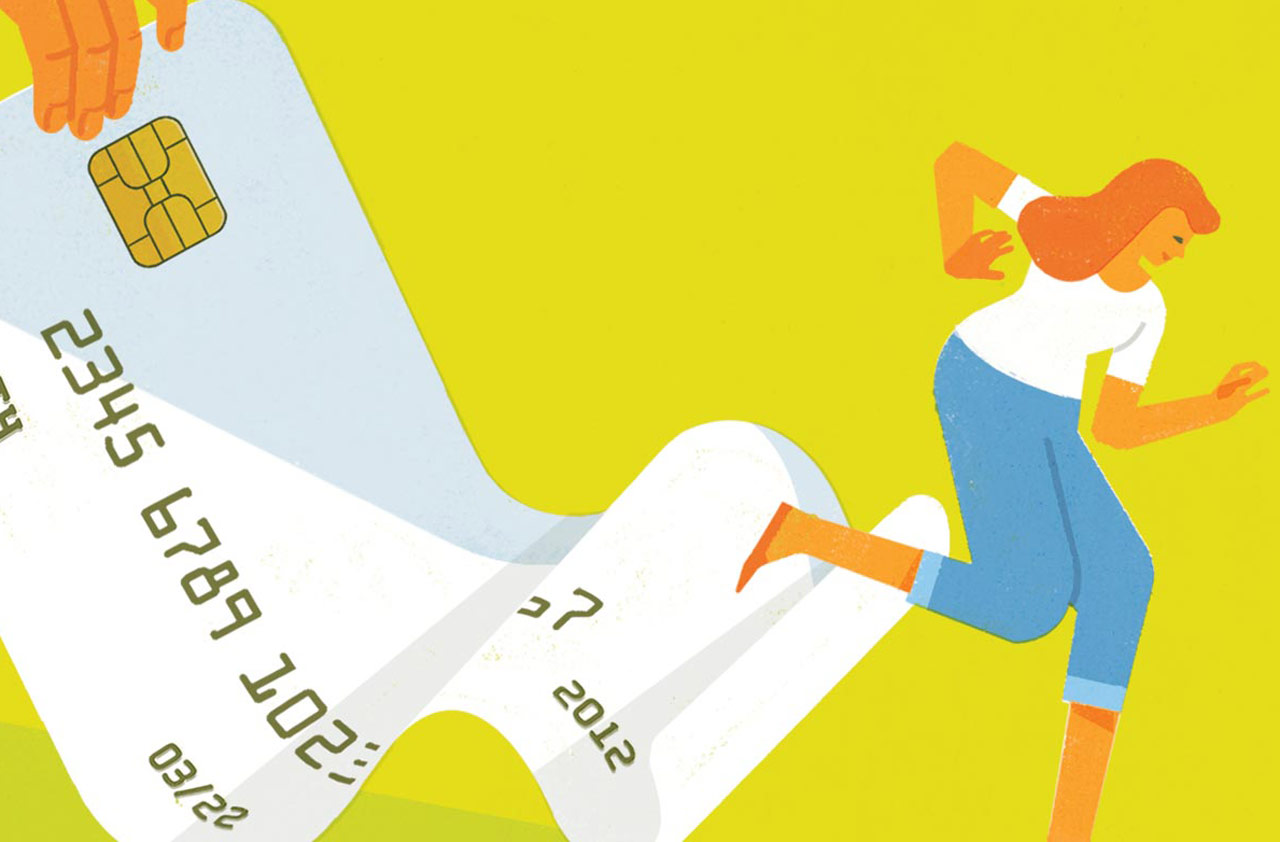5 Ways to Max Out Your Credit Card Rewards
Play your cards right and a first-class flight, luxe hotel suite or a pile of cash can be yours.

If you’re using a single rewards card that pays only one point or cent per dollar spent on your purchases, it may be time to rethink your strategy. With three or four carefully chosen cards in your wallet, you can bank enough points and miles to kick back in first class or lounge in a plush hotel suite. If travel is not your thing—or you don’t want to spend time studying the ins and outs of award charts—you can still earn hundreds of dollars in cash back each year by rotating your spending among credit cards that match your spending patterns.
Melissa Frank, director of recruitment for an education technology nonprofit, holds nine cards. The Long Island, N.Y., resident delegates different purchases to different cards—for example, all travel goes on her Chase Sapphire Reserve Visa ($450 annual fee). Her points have taken her to South Africa in business class twice, helped treat her dad to a rain forest adventure in Peru, and cut the cost of numerous jaunts around the U.S. “I can’t think of one instance in recent times that I have paid full price out of pocket for a flight,” she says.
Whether you want to dabble in credit card rewards or dive in deep, these five strategies will help you milk more value from your points and miles. You can combine tactics to earn even greater rewards. (Unless noted otherwise, the cards we recommend do not carry annual fees; for additional picks in a variety of categories, go to The Best Rewards Cards, 2019.)

Sign up for Kiplinger’s Free E-Newsletters
Profit and prosper with the best of expert advice on investing, taxes, retirement, personal finance and more - straight to your e-mail.
Profit and prosper with the best of expert advice - straight to your e-mail.
Don’t worry that strategies to max out rewards will lower your credit score. That won’t happen as long as you avoid a few common traps. In fact, your credit score may go up.
1. Concentrate on cash back. Best if: You want an easy and instant return, value total flexibility with your rewards, or travel infrequently.
Cash back may not have the panache of high-end travel rewards, but it’s simple, versatile and doesn’t lose value over time the way that loyalty points do. Among credit card users who say rewards are the feature they look for most in a credit card, 67% favor cash back over points or other reward types, according to a report from CreditCards.com.
Miguel Suro, a lawyer in Miami, and his wife, Lily, divide their spending among three cards: Amazon Prime Rewards Visa Signature, for 2% back on gas and 5% back on Amazon.com purchases; Citi Prestige Mastercard ($495), for five points per dollar spent on dining; and Chase Freedom Unlimited Visa, for 1.5% cash back on everything else. But he and Lily are rethinking the strategy because no-fee cash-back cards with generous rewards make more sense for them as new parents. “When you first read about travel hacking, you’re excited by the promises of amazing trips around the world in first class. But it takes a lot of time and energy to research,” he says. “Now that we are traveling less and buying lots of baby stuff, cash back is more attractive.”
The easiest method to rev up your cash-reward rate is to rely on a single card that earns more than 1% per dollar spent. Citi Double Cash Mastercard pays a flat 2% on all purchases, as does the Fidelity Rewards Visa Signature (but you must deposit your rewards from the card into a Fidelity account). Other cards, such as the Capital One Quicksilver Visa, return 1.5% on everything.
Next, layer on one or two more cards with higher payback in categories in which you spend the most, such as dining, groceries or gas. Dining is a hot category right now, with several cards, including the Uber Visa and Capital One Savor Rewards Mastercard ($95 annual fee, waived the first year), earning 4% or more at restaurants.
Sticking with cash-back cards that offer fixed bonus categories is easiest. If you choose cards such as the Chase Freedom Visa or Discover It, which hike earnings on new categories to 5% each quarter, you will need to activate the categories each quarter to earn the higher rate. (Recent 5% categories on those cards included home improvement stores, grocery stores, gas stations and ride sharing. Fourth-quarter categories usually focus on shopping.)
A couple of other cards, including the U.S. Bank Cash+ Visa Signature, let you choose the categories that earn additional cash back, including such options as TV, internet and streaming services, home utilities, and cell-phone bills. Stay away from retail cards unless you’re loyal to that store and shop there frequently, says Ted Rossman, industry analyst at CreditCards.com. “The sign-up bonuses are lacking compared with general-purpose cards, and even the ongoing rewards are not as attractive,” he says.
Some cash-back cards have a catch: They cap your bonus earnings each year or quarter and drop the rate to 1% once you hit your limit. You may not worry about blowing through a $1,500 quarterly cap on, say, gas and drugstores, but a family could easily surpass the $6,000 annual limit for 6% cash back on groceries with the American Express Blue Cash Preferred ($95). Track your spending so you can revert to a card that earns more than 1% back until the clock resets. At the same time, familiarize yourself with how your credit card issuer defines its categories. For example, it’s common for credit cards to exclude gas or groceries from the top-earning gas or grocery category when you buy those items at superstores, such as Walmart and Target, or wholesale clubs, such as Costco Wholesale and Sam’s Club.
2. Target sign-up bonuses. Best if: You want to earn a hefty stash of points in a hurry or have a specific travel goal in mind. The Chase Sapphire Reserve made a splash in 2016 with its 100,000-point sign-up bonus. Mega bonuses are harder to come by these days, as issuers crack down on “churners” who drop a card after earning the bonus. Instead, issuers are focusing on ongoing rewards—such as high returns for everyday spending, says Rossman.
Still, the average sign-up bonus currently sits at an all-time high of 20,153 points or miles, according to WalletHub. New cardholders can generally expect to earn up to 50,000 or 60,000 points on travel cards with annual fees after spending several thousand dollars in the first three or four months. Sign-up bonuses on no-fee travel cards are lower, and cash-back cards typically offer $150 or $200 after spending $1,000 or less in the first few months. Discover It and Discover It Miles double all of the rewards you earn after your first year as a cardholder.
Sign-up bonuses are a useful way to bulk up your stash of points in a hurry, but new cardholders can fall into traps. For one, the size of a welcome bonus can be misleading. “The headline number isn’t as important as what those points are worth,” says Julian Mark Kheel, senior analyst at ThePointsGuy.com. For example, he says, a 100,000-point bonus on a Hilton Honors card is not worth nearly as much as the 60,000-point bonus you get with the Chase Sapphire Preferred Visa ($95). (ThePointsGuy.com lists valuations of credit card points and miles at ThePointsgGuy.com's monthly valuations guide.)
Issuers are also placing more restrictions on when you can and can’t get a bonus. American Express, which limits cardholders to one bonus per card per lifetime, will tell you before you complete your application whether you are eligible for the bonus. With other issuers, you may need to read the offer terms because, says Kheel, some banks will give you a card even if you’re not eligible for the bonus, and you won’t realize it until after you’ve used the card.

Illustration by Chris Gash
Your credit score won’t take a hit
Holding multiple credit cards won’t hurt your credit score. In fact, it may boost your score. Although your score will fall a few points every time you apply for a new card and the lender performs a “hard” inquiry, inquiries are a small component of your overall score.
Your credit utilization ratio—the amount you owe on your credit cards as a proportion of your cards’ limits—is a bigger piece of your credit score, and it should improve as you add new cards to your collection and increase your available credit. (See 6 Ways to Boost Your Credit Score—Fast.)
To lessen the impact of new inquiries on your credit score and more easily meet spending requirements for bonuses, space out your applications to every six months or more. Waiting six months to open a new card can also help you circumvent Chase’s “5/24 rule,” which prevents you from opening a Chase card if you have opened five or more credit cards (from all issuers) within the past 24 months. Many issuers also restrict how many of their cards you can open in a one-, two- or three-month period.
If you carry a balance, move it to a card with a low or zero-percent rate. Rewards cards tend to carry higher interest rates than other credit cards.
Best ways to cash in
You’ll get the most bang for your buck by redeeming the points and miles you acquire from travel cards for travel, especially first- or business-class seats on international flights. “You can get an $8,000 ticket for less than 200,000 miles,” says Brian Karimzad, co-founder of personal finance site MagnifyMoney.com.
If you want to spring for a special vacation, one way to strategize your redemption is to work backward: Decide where you want to go, which airlines will take you there, and which hotels you might want to stay at. Then zero in on cards with the best rewards potential and the best transfer partners. Before you move your points, check the going rate with each partner. Some tricks are counterintuitive. For example, you can use Virgin Atlantic miles to reserve Delta flights for less than Delta would require with its own miles.
Aim for a return of 2 cents or more per mile. (To calculate the value of your miles, divide the cash price of the ticket by the number of miles needed to book it.) It may be more economical to book through the travel portal, especially if you can redeem your points at more than 1 cent each. If you redeem travel points for non-travel statement credits, merchandise or gift cards, the rate may be less than a penny apiece.
If you’re counting on a stack of points to pay for an upcoming trip, leave plenty of time for your rewards to post because that may take up to 12 weeks. But avoid hoarding miles for more than one or two years because they devalue over time.
Cash-back cards usually let you redeem the rewards as a statement credit, check or bank account deposit at a rate of 1 cent per point. Merchandise is typically the worst value, according to WalletHub’s 2019 credit card rewards report. Gift cards will sometimes bake in a small premium if you buy them with your card earnings.
Get Kiplinger Today newsletter — free
Profit and prosper with the best of Kiplinger's advice on investing, taxes, retirement, personal finance and much more. Delivered daily. Enter your email in the box and click Sign Me Up.

-
 Customer Services are Strained at the SSA, You Should Plan Around These Federal Holidays
Customer Services are Strained at the SSA, You Should Plan Around These Federal HolidaysIf you have a question or need information from a federal agency, check the federal holiday schedule to make sure you get your business done before they close.
By Donna LeValley
-
 Stock Market Today: No 'Powell Put'? No Problem
Stock Market Today: No 'Powell Put'? No ProblemInvestors, traders and speculators look beyond both another Trump post and more signs of slowing economic activity.
By David Dittman
-
 Roth IRA Contribution Limits for 2025
Roth IRA Contribution Limits for 2025Roth IRAs Roth IRA contribution limits have gone up. Here's what you need to know.
By Jackie Stewart
-
 Four Tips for Renting Out Your Home on Airbnb
Four Tips for Renting Out Your Home on Airbnbreal estate Here's what you should know before listing your home on Airbnb.
By Miriam Cross
-
 Five Ways to a Cheap Last-Minute Vacation
Five Ways to a Cheap Last-Minute VacationTravel It is possible to pull off a cheap last-minute vacation. Here are some tips to make it happen.
By Vaishali Varu
-
 How to Figure Out How Much Life Insurance You Need
How to Figure Out How Much Life Insurance You Needinsurance Instead of relying on rules of thumb, you’re better off taking a systematic approach to figuring your life insurance needs.
By Kimberly Lankford
-
 Amazon Big Deal Days Is Coming! We’ve Got All the Details
Amazon Big Deal Days Is Coming! We’ve Got All the DetailsAmazon Prime To kick off the holiday season with a bang, Amazon Big Deal Days runs Tuesday, October 8 and Wednesday, October 9.
By Bob Niedt
-
 How to Shop for Life Insurance in 3 Easy Steps
How to Shop for Life Insurance in 3 Easy Stepsinsurance Shopping for life insurance? You may be able to estimate how much you need online, but that's just the start of your search.
By Kaitlin Pitsker
-
 Five Ways to Shop for a Low Mortgage Rate
Five Ways to Shop for a Low Mortgage RateBecoming a Homeowner Mortgage rates are high this year, but you can still find an affordable loan with these tips.
By Daniel Bortz
-
 Mastercard Says It Is Not Raising Network or Swipe Fees
Mastercard Says It Is Not Raising Network or Swipe FeesCard processing giant says WSJ story on credit card fee hikes ‘is wrong.’
By Joey Solitro